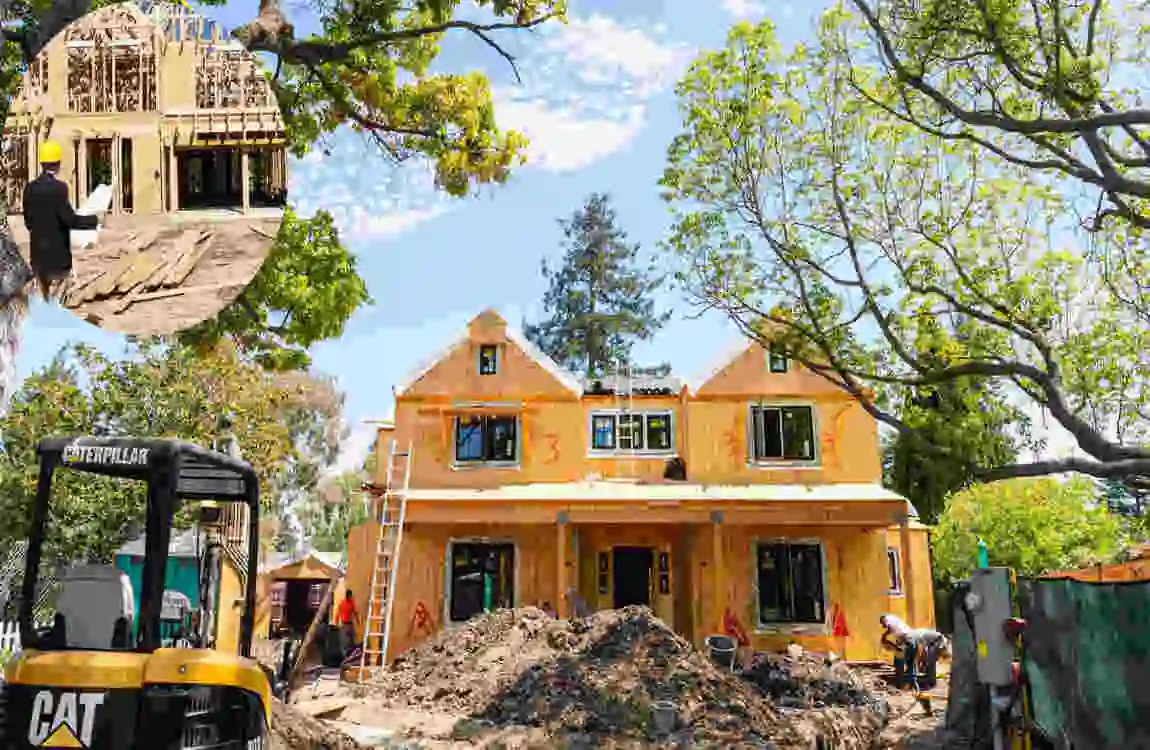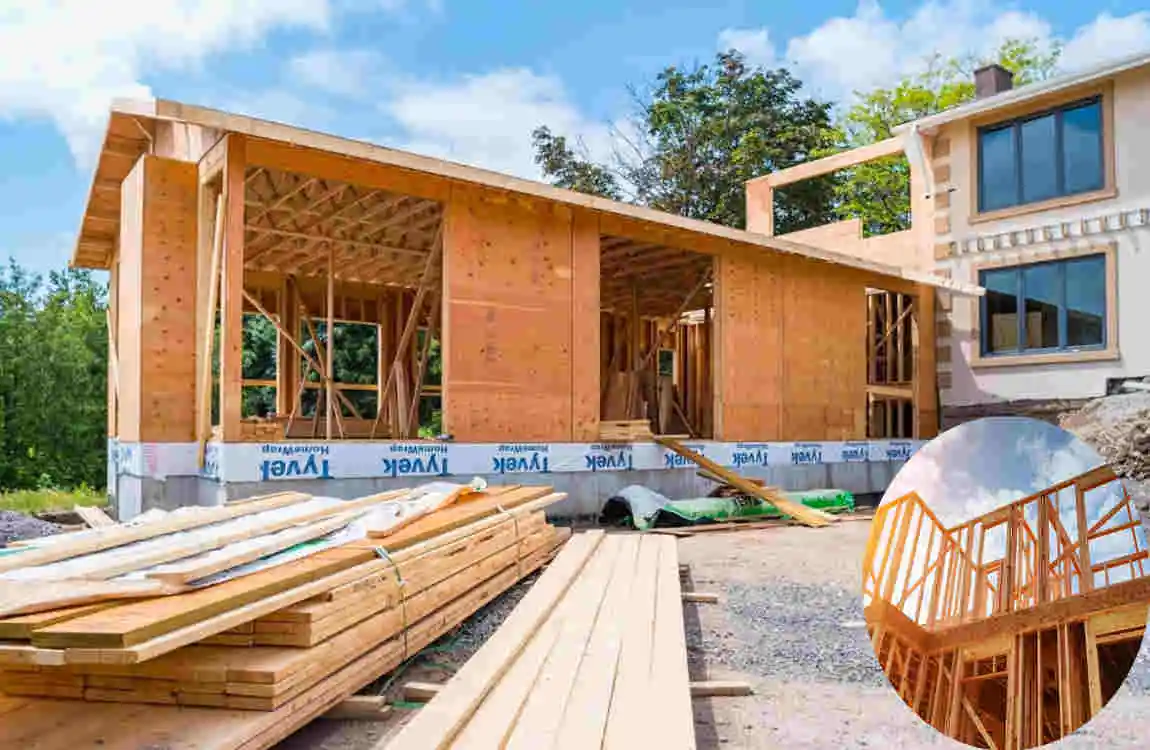Mastering the timeline for finishing your house framing is crucial to keeping your home construction on track. Framing is the stage where your home’s skeleton takes shape, including the floors, walls, and roof trusses. It typically takes 1 to 2 months and marks a transformative phase as your blueprints become a tangible structure. Timely completion of framing sets the foundation for subsequent phases such as installing windows, roofing, and mechanical systems, helping to ensure the overall success and timely delivery of your dream home.
What is House Framing?

House framing is the process of constructing the structural framework that supports a building. It acts like the bones of your home, providing shape and stability.
Typically made from wood or metal, framing involves creating walls, floors, and ceilings. These elements are interconnected to form a sturdy shell that will eventually support everything else—like roofing and siding.
The most common style is platform framing, where each floor is built separately on top of the others. This technique allows for easier construction and better insulation.
Framing also includes considerations for windows and doors, ensuring they fit perfectly within the structure. Proper alignment here is essential for aesthetics as well as functionality.
Understanding this foundational step provides insight into how homes are built to last through various weather conditions while maintaining energy efficiency.
The Importance of Proper Framing
Proper framing is the backbone of any construction project. It provides structural integrity and ensures that your house can withstand environmental stresses like wind, snow, and seismic activity.
You may also read (step by step guide to korean house style decor).
When done correctly, framing allows for better energy efficiency. Well-aligned walls and windows create air-tight seals that reduce heating and cooling costs. You’ll appreciate this in the long run.
Moreover, proper framing sets the stage for everything else in your build. It impacts plumbing, electrical work, and even drywall installation. If the framework isn’t right from the start, it creates a domino effect of problems down the line.
Beyond functionality, there’s an aesthetic aspect to consider as well. Straight lines and symmetrical rooms contribute to a pleasing visual appeal that enhances property value.
Neglecting good practices often leads to costly repairs or renovations later on. Investing time in solid framing pays off significantly over time.
Materials and Tools Needed for House Framing
Selecting the right materials and tools is crucial for successful house framing. First, you’ll need quality lumber. Common choices include 2x4s and 2x6s for walls, joists, and rafters.
Nails are essential, too. Opt for galvanized or stainless steel to prevent rusting over time. A nail gun can make your work faster and more efficient.
Don’t forget about adhesives. Construction adhesive adds extra strength to joints and connections.
Tools play a vital role as well. A circular saw is a must-have for cutting lumber accurately. A level ensures everything stays straight throughout the process.
Safety gear shouldn’t be overlooked either. Always wear gloves, goggles, and a hard hat when working on-site to protect yourself from potential hazards.
Having these materials and tools ready will streamline your framing project significantly, setting the stage for success in building your home.
Steps to Mastering the Timeline of House Framing

Creating a timeline for house framing is crucial. Start by planning each phase carefully. Break down the project into manageable tasks.
Begin with site preparation. Ensure that the land is level and that obstacles are cleared away. This sets a solid foundation for your framing work.
Next, focus on laying out the framework accurately. Use precise measurements to avoid costly errors later on. Mark your lines clearly before cutting any materials.
Once you have established your layout, move quickly to erecting walls and installing beams. Coordination among team members speeds up this process significantly.
Keep an eye on weather conditions as they can impact timelines unexpectedly. Always have contingency plans in place for delays caused by rain or snow.
Maintain open communication throughout the project. Regular updates help everyone stay aligned and aware of their responsibilities at all times.
Common Mistakes to Avoid in House Framing
One frequent mistake is overlooking the importance of a solid foundation. If the base isn’t level or stable, your framing will suffer. Always double-check measurements before starting.
Another common pitfall is neglecting to account for local building codes. These regulations are in place for safety and compliance. Skipping this step can lead to costly fines or necessary rework.
Many also underestimate the significance of selecting quality materials. Cheap lumber may save money initially, but it often results in structural issues down the line.
Improperly aligning studs can also create complications later on. Each stud should be spaced correctly to support walls and roofs effectively.
Communication gaps among team members can derail progress. Ensure everyone understands their roles and responsibilities to maintain workflow efficiency throughout the project.
Tips for a Smooth and Efficient Process
To ensure a smooth and efficient house framing process, communication is key. Keep everyone informed about the project timeline and expectations. Regular updates help maintain focus.
Organize your workspace. A clutter-free environment allows for better movement and reduces the chances of accidents or misplacing tools. Designate areas for materials, equipment, and waste disposal.
Prioritize safety measures as you work. Wear appropriate gear such as gloves, helmets, and goggles to prevent injuries. Establish a clear protocol for handling heavy materials.
Time management is crucial. Create a detailed schedule that outlines each phase of framing. Stick to it as closely as possible while allowing some flexibility for unexpected challenges.
Don’t hesitate to ask for help when needed. Whether it’s from friends or professionals, collaboration can speed up the process significantly without compromising quality.
You may also read (step by step guide to lewiston me courthouse procedures).




